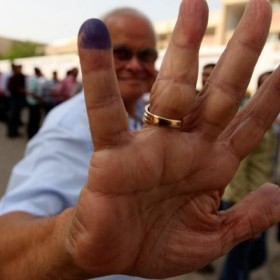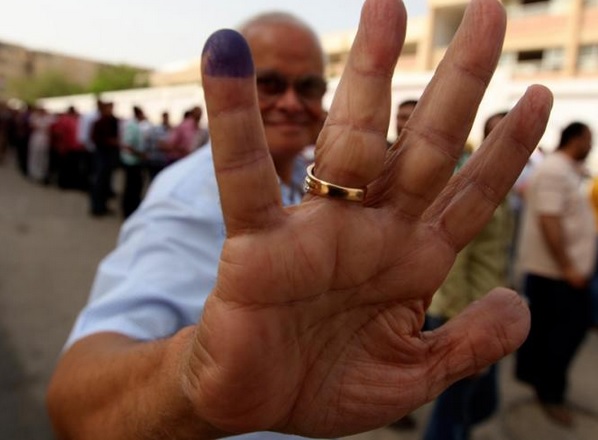
Photo courtesy of English al-Akhbar News
Today, the world encompasses varying forms of government, from tribal rule to family monarchies. About half of all governments are listed under some form of democratic rule, yet only fifteen percent practice a fully functioning democracy.[ref]Kavitha Davidson, “Democracy Index 2013: Global Democracy at a Standstill, The Economist Intelligence Unit’s Annual Report Shows,” The Huffington Post, accessed July 29, 2015, http://www.huffingtonpost.com/2013/03/21/democracy-index-2013-economist-intelligence-unit_n_2909619.html.[/ref] America has blazed the path for democracy in the international sphere. The promotion of democracy has been an overwhelming agenda for the superpower that is the United States of America. As the U.S. has grown in strength after both World Wars, the country decided to spread its democracy – beginning with a physical presence in Vietnam and Korea, and numerous policies affecting non-democratic states such as Iran and Panama. Within a superpower, the topic of democratization is fitting.
The case for an international community of democracy is strong. To list a few benefits, democracy increases economic development, innovation, and human rights. The United States has made it a priority to promote human rights and freedom to our international community. But how successful are the endeavors of the United States in instilling democracy and nation building? How can the U.S. effectively support democratization all throughout the globe, while supporting state sovereignty, maintaining a good international reputation, and winning the hearts and minds of the people?
The strong arm for democracy began after World War Two (WWII). The North Atlantic Treaty Organization, or NATO, and the U.S. joined hands to influence the democratization of Italy, Spain, West Germany, and Portugal. The influence spread forward into a full-fledged Cold War, where the U.S. isolated other forms of governance in Russia, Cuba, and China. The Cold War was a non-invasive war, with minimal death on the American and Russian side. This type of unconventional war forced innovation and competition. During the Cold War, the race for technology greatly benefited both countries. Amidst the arms race, Americans landed on the moon, set the path for the Internet, and satellite imaging.
During that innovative time, a stark comparison is shown.
The Vietnam War is a well documented failure. 58,220 Americans were killed, and countless Vietnamese. [ref]”Statistical Information about Casualties of the Vietnam War,” National Archives and Records Administration, accessed July 29, 2015, http://www.archives.gov/research/military/vietnam-war/casualty-statistics.html.[/ref] America never successfully stopped the bleeding – terrorism is still rampant, recovered, or made a movement to self-sufficiency. To stop this, the insurgent cause was never broken in strength or momentum. The Vietnamese took on a strong will and were willing to come out victorious by whatever means possible.[ref]David H. Petraeus and James F. Amos, Counterinsurgency Field Manual, (Washington D.C: United States Marine Corps, 2006), 1-7[/ref] The continued strength of the insurgency never allowed the population to be completely secure or view the counterinsurgency efforts as legitimate. When America moved on to the recovery phase, their problems continued. The US armed and equipped the Vietnamese to build the capacity of their security forces. However, the American way of war was incompatible with their culture. The agriculture-based economy couldn’t operate and sustain the equipment. These shortcomings lead to poor administration and rampant corruption in the forces.[ref]Ibid, 8-10.[/ref] To continue on the path of failure, there was never a movement to self-sufficiency. The US should build host nation institutions that are viable without US support. And if this takes too long, as it did in Vietnam, the local population questions the legitimacy of the counterinsurgency operation and their own government.[ref]Ibid, 1-28.[/ref]
The failure of the approach can be attributed a couple of things. The American forces never fully understood the Vietnamese and used too much of a military stance. In Vietnam, the idea of communism was tied in to the idea of a national Vietnamese state and the Americans failed to see how strong they adhered to communism. The failure can also be attributed to the stubbornness of the American effort, unready to change to the situation and bring about a different approach. [ref]John A. Nagl, “Learning to Eat Soup with a Knife,” World Affairs 161.4, 1999, 195 [/ref]
Iraq and Afghanistan are two recent failures as well. The reasons both wars failed is similar to the case of Vietnam – the basic failure to understand culture. Specifically for Iraq, the U.S. did not understand the centuries old war between Shiite and Sunni sects of Islam – and the outpouring effect this sect has on the nation. For Afghanistan, Americans did not grasp their tribalism and how intertwined their tribes are in government. The U.S. mentality to force feed democracy is unsuccessful.
Instead, non-invasive methods of democratization may be more effective than military methods. To be specific, rather than resort to guns and war to create peace, the U.S. should send economic development packages and strengthen education efforts, in hopes of helping more efficiently.The case of Egypt serves as an excellent case study to this method. US-Egypt relationships flourished after the Camp David Accords in 1978. Americans have been giving economic aid to avoid international war with Israel, and the benefits have been endless. They have staged their own successful revolution for democracy, and are now frequenting elections. Instead of coming in and trying to give them our way of government, the U.S. respected Egyptian choices and helped their country flourish.
Take Action:
Let’s avert our attention to human rights to Human Rights Watch, and specifically what we can do to help with human rights.




